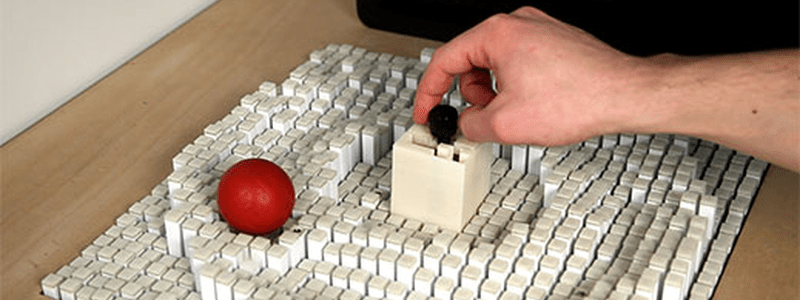Remember pin art? That’s the little box full of pins that you can push something into and the pins take on the shape. You usually use your hand, but any small object works (including, if you are brave enough, your face). [Sean Follmer] (formerly at the MIT Media Lab) developed the reverse of this: a surface made of pins driven by motors. Under computer control, the surface can take on shapes all by itself.
The square pins can be seen in the video below moving and manipulating blocks and using them to build structures out of the blocks. By using the right sequence of pin motions, the blocks can be flipped and even stacked. Magnetic blocks offer even more options.
The developers hope the device will be useful in telepresence and manufacturing applications. Special modules can convert the vertical motion into other types of behavior (like rotation). You can see examples of that near the end of the video.
This looks like it could be fairly simple for hackers to replicate. The ACM paper that announced the work has a lot of detail on the methods used to move and manipulate blocks, but not much detail on the mechanism. But it shouldn’t be too hard to figure out something similar.
This isn’t the first smart tabletop we’ve seen, but it may be the most physically active. Most projects we’ve seen passively sense the world, but fall short of manipulating it.
















Cool!
I’ed love to see a human sized model, floor surfing!
You would get something like aperture science test chambers.
I’m making a note here….. Huge Success!!
I really doubt one’s face is the bravest thing that has been stuck in one of those.
I’m going to admit that had never crossed my mind. Now, I’m much less likely to pick one up off someone’s desk, though. Thanks for that. ;-)
Pixel, voxel, axolotl!
That last word is Mayan.
Small air cylinder for each pin?
I recently talked to Daniel Leithinger, who was also part of the team which developed this. I understood that it works with ALPS motorized faders as actuators.
Ouch! Not even AliExpress makes that affordable.
I had 26 to replace in an organ, belt failure. At $30 or so per unit, I modded the space and fit small “o” rings instead of the much lighter tiny unobtainable belts.
I immediately thought of that table from X-Men:
https://www.youtube.com/watch?v=AP4TofuJQ1o
Think of the uses this would have for blind people. Had a similar (smaller) idea years ago that used multiple dot-matrix print heads.
They already make pin-displays for Braille, usually only one line that you scroll up and down a page. Just one line because they’re so expensive.
http://hackaday.com/2013/11/07/inform-mits-morphing-table/
I should have linked that post. However, if you look, the recent MIT paper is about how they use the table to manipulate the cubes. But, yeah, same table.
Blistex tubes actuated by cheap DC motors, maybe.
http://makezine.com/projects/make-34/the-mighty-lip-balm-linear-actuator/
What would be clever, is software that figures out how to do the manipulation without being told. Just tell it what you want, throw on some parts, and come back later.
Still, it’s probably always going to be better to just use robot arms. For the same amount of motors / expense / time I’d bet robot arms could beat this every time. Similarly for shifting things about warehouses, conveyors and forklifts are better.
I’m not usually a betting man. But I would put a bet on throwing the dice and getting a 4.
Or an 8 if I through two.
If I didn’t get a 4, then I’ll get the table to tip the dice until it was a 4 and nobody was looking.